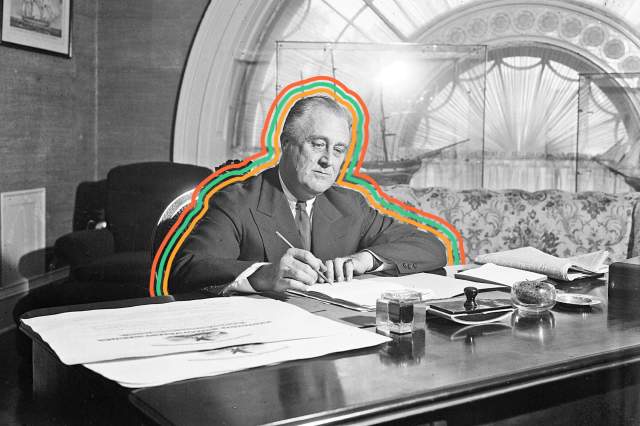
FDR Was a Birder
Growing up in Dutchess County, New York, a young Franklin Delano Roosevelt became obsessed with birds. The future President collected eggs and kept them in drawers in his childhood bedroom, shot and classified over 300 birds in his county, and frequently gave impromptu lectures to family and friends about birds and their migratory patterns. FDR’s passion for ornithology, and natural history more generally, likely contributed to his impressive environmentalism record when he became President many decades later.

FDR Is Distantly Related to 11 Other Presidents
Genealogists have determined that Roosevelt was distantly related to 11 other U.S. Presidents — five Presidents by blood and another six by marriage. The most obvious relative is former President Theodore Roosevelt, who was FDR’s fifth cousin (and the uncle of FDR’s wife, Eleanor). The other U.S. Presidents include John Adams, James Madison, John Quincy Adams, Martin Van Buren, William Henry Harrison, Zachary Taylor, Andrew Johnson, Ulysses S. Grant, Benjamin Harrison, and William Howard Taft. Roosevelt was also distantly related to major World War II figures, including Winston Churchill and Douglas MacArthur.

FDR’s First Appearance on a Presidential Ticket Was for VP in 1920
Roosevelt became a member of the New York Senate in 1910. He helped propel Woodrow Wilson to the presidency in 1912, and Wilson returned the favor by appointing Roosevelt assistant secretary of the Navy. In 1920, Franklin reached the national stage as Vice President on the Democratic ticket, along with presidential hopeful and governor of Ohio James Cox.
But the Democrats didn’t prevail that year: The Republican ticket, headed by Warren G. Harding, campaigned on a promise to “return to normalcy” following the end of World War I. The message resonated with voters, and Harding, along with VP Calvin Coolidge, won a landslide victory.
Yet FDR’s star rose after he became governor of New York in 1928. He took on the corrupt Tammany Hall political machine, which eventually led to its downfall. By 1932, he was a clear candidate for President in the Democratic Party.
More Interesting Reads

He Served Two More Terms Than Any President Ever Will
Franklin Roosevelt is remembered for many things, but one reason his impact looms so large in American history is because he was elected commander in chief four times — double any other U.S. President. George Washington set a precedent when he served only two terms in the late 18th century, and future Presidents more or less followed this tradition (though FDR’s cousin Theodore Roosevelt ran for a third term). After Roosevelt’s historic 12 years in office (he died early into his fourth term), the U.S. Congress passed the 22nd Amendment, officially limiting any future President’s time in office to two terms.

FDR Considered Japanese Internment Years Before WWII
Years before the attack at Pearl Harbor, the U.S. Navy watched Japan’s growing militarism in the Pacific, and some grew worried about the large Japanese American population in Hawaii. In 1936, Franklin called for some Japanese citizens and non-citizens to be “secretly but definitely identified” and “placed on a special list of those who would be the first to be placed in a concentration camp in the event of trouble.”
Seven years later, FDR’s Executive Order 9066 authorized the evacuation of people deemed a threat to national security from the West Coast to relocation centers — which resulted in moving more than 100,000 people of Japanese descent into internment camps. It remains a dark day in U.S. history. Four decades later, Ronald Reagan signed the Civil Liberties Act of 1988, which paid reparations to wronged Japanese Americans while hoping to “discourage the occurrence of similar injustices and violations of civil liberties in the future.”

He Was the First President To Be Seen on TV
Although Roosevelt is famous for his fireside chats broadcast via radio, the nation’s 32nd President was also the first to ever be seen on television. The President appeared on TV during the World’s Fair in New York in 1939, although only a handful of TV sets in the area were able to actually watch the broadcast. As World War II exploded across Europe and Asia, and TVs became more commonplace in American homes, FDR became the first President to really use the emerging medium. FDR was also the first President to ever fly on an airplane for official presidential business (though FDR’s fifth cousin Theodore was the first President to ever fly in a plane overall).

FDR Is One of the Greatest Figures in History With a Disability
In 1921, when he was 39 years old, FDR was stricken with polio (or perhaps Guillain-Barré syndrome), a disease which at the time had no known cure. For the rest of his life, he was totally paralyzed from the waist down. In the 1920s, it was common to send disabled people to asylums or banish them from society altogether. But after years of rehabilitation, Roosevelt learned to cope with his disability and continued his political life. During his presidency, the media largely (though not always) avoided discussing his paralyzation. His Secret Service was also known to confiscate or destroy film that showcased the disability. However, the American public largely sympathized with FDR and saw him as a man who triumphed over his disability rather than a victim of it.











